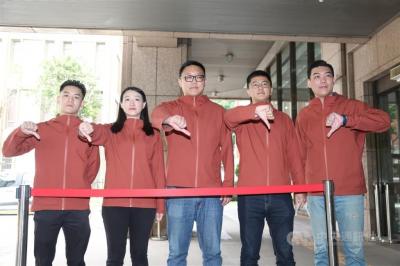Barely two weeks after splashing photographs of an aircraft carrier on the Internet, China’s state media on Monday published what it claimed were the first close-up pictures of a J-15 carrier-based fighter aircraft.
The day before, Web sites that focus on China’s military had run the same photographs, snapped outside the Shenyang plant in northeast China where the plane is being developed.
The J-15 Flying Shark has the folding wings, shortened tail cone and hardened landing gear that would allow it to serve on China’s first aircraft carrier, which is expected to start sea trials soon.
Some analysts said this was indisputable evidence of China’s growing mastery of military technology.
Like the aircraft carrier it will call home, the jet faces years of tests and refinement before it will formally enter service, military analysts said.
The photographs nevertheless suggest that the People’s Liberation Army, long notoriously secretive, is lifting some veils.
“The recent spate of releases of photographs of airplanes under development is a sign of relaxed control of military information in China,” Lan Yun, an editor at the Beijing-based Modern Ships magazine, said in an interview.
“It could be seen as a sign of more transparency of the Chinese military,” Lan said.
Lan and Andrei Chang, the Hong Kong-based editor of Kanwa Asian Defense Review, said the photograph indicated that the aircraft had passed factory tests and was now bound for flight-testing.
Internet posts by analysts and Chinese aviation enthusiasts pointed to a fighter crammed with the best technology China can produce: holographic “heads-up” instrument displays, advanced anti-ship radar and, Lan said, self-guiding missiles, in contrast to the gravity-controlled bombs and sight-guided missiles that largely populate China’s existing 3,200-aircraft fleet.
When it is deployed — probably sometime after 2015 — the J-15 will signal the dawn of a new ability by China to assert authority along its coastline and possibly into the South China Sea.
China’s aircraft carrier, still known by its old name Varyag, is a retrofitted version of a 1988 Soviet aircraft carrier that Chinese interests bought from Ukraine after the 1991 collapse of the Soviet Union, supposedly for conversion into a floating casino in Macao.
However, the Macao gambling license never materialized and, as many had suspected, the ship wound up elsewhere — in Dalian, where workers began a decade-long retrofit.
China is also reportedly working on a nuclear-powered aircraft carrier, which is scheduled for completion around 2020.
The J-15 has followed an even more tortuous route.
At the turn of the century, many news reports said the Chinese beseeched Moscow to sell them the Sukhoi-33, a 1980s Soviet fighter capable of landing on carriers. Moscow refused.
However, in 2001, the Chinese bought a Su-33 prototype from Ukraine and began a teardown to learn its secrets. The Russians were incensed.
Yet the J-15 unofficially unveiled this week, which externally seems a clone of the Su-33, in fact has been remade inside with Chinese improvements.
Lan said that advances in the plane’s outdated avionics and missile-guidance systems had made it a far more sophisticated version of the original Russian jet.
The J-15 is being compared in some quarters to the US F-18, a workhorse on US Navy carriers.
However, Lan said it had a shorter range, in large part because its takeoff method — flying off a ski-jump-style runway — dictated that it could carry less fuel than a comparable US jet, which is propelled off a flat carrier deck.
Flying a ski-jump requires considerable training. In February, a Ukrainian court convicted a Russian man of conspiring to give the Chinese details of a Crimean air base that had been used to train Su-33 pilots to take off from a carrier’s ski-jump ramp.
In Huludao, a navy installation in Liaoning Province, workers are said to have built a rough clone of the Crimea test center, complete with a ski ramp for ascending jets.
Contacted by the Taipei Times for comment, Rick Fisher, a senior fellow at the International Assessment and Strategy Center in Washington, said one should always be cautious with print stories about new Chinese weapons that only appear on Chinese Web pages.
In his view, Chinese state media have developed the habit of picking up material posted on Web pages and turning it into news stories so that Western media will propagate the message that “China is getting bigger and badder.”
“What we are seeing is that like the ‘unveiling’ of the J-20 in January, the Chinese propaganda department is getting into the habit of using Internet military enthusiasts to ‘project power’ in a propaganda sense,” he said.
That said, Fisher said there were reasons to consider that some of the programs detailed in Chinese media are real, he said.
The pictures come amid unconfirmed reports that China earlier this month flight-tested at a base in Inner Mongolia another aircraft based on the Su-33 design known as the J-18 Red Eagle.
However, unlike the J-15, the J-18 reportedly has vertical/short take-off and landing (VSTOL) capabilities akin to that seen on Lockheed Martin’s F-35 fighter. Both the J-15 and J-18 would be carrier-based.
ADDITIONAL REPORTING BY J. MICHAEL COLE

Taiwan is stepping up plans to create self-sufficient supply chains for combat drones and increase foreign orders from the US to counter China’s numerical superiority, a defense official said on Saturday. Commenting on condition of anonymity, the official said the nation’s armed forces are in agreement with US Admiral Samuel Paparo’s assessment that Taiwan’s military must be prepared to turn the nation’s waters into a “hellscape” for the Chinese People’s Liberation Army (PLA). Paparo, the commander of the US Indo-Pacific Command, reiterated the concept during a Congressional hearing in Washington on Wednesday. He first coined the term in a security conference last

Prosecutors today declined to say who was questioned regarding alleged forgery on petitions to recall Democratic Progressive Party (DPP) legislators, after Chinese-language media earlier reported that members of the Chinese Nationalist Party (KMT) Youth League were brought in for questioning. The Ministry of Justice Investigation Bureau confirmed that two people had been questioned, but did not disclose any further information about the ongoing investigation. KMT Youth League members Lee Hsiao-liang (李孝亮) and Liu Szu-yin (劉思吟) — who are leading the effort to recall DPP caucus chief executive Rosalia Wu (吳思瑤) and Legislator Wu Pei-yi (吳沛憶) — both posted on Facebook saying: “I

The Ministry of Economic Affairs has fined Taobao NT$1.2 million (US$36,912) for advertisements that exceed its approved business scope, requiring the Chinese e-commerce platform to make corrections in the first half of this year or its license may be revoked. Lawmakers have called for stricter enforcement of Chinese e-commerce platforms and measures to prevent China from laundering its goods through Taiwan in response to US President Donald Trump’s heavy tariffs on China. The Legislative Yuan’s Finance Committee met today to discuss policies to prevent China from dumping goods in Taiwan, inviting government agencies to report. Democratic Progressive Party Legislator Kuo Kuo-wen (郭國文) said

The Ministry of Economic Affairs has fined Taobao NT$1.2 million (US$36,900) for advertisements that exceeded its approved business scope and ordered the Chinese e-commerce platform to make corrections in the first half of this year or its license would be revoked. Lawmakers have called for stricter supervision of Chinese e-commerce platforms and more stringent measures to prevent China from laundering its goods through Taiwan as US President Donald Trump’s administration cracks down on origin laundering. The legislature’s Finance Committee yesterday met to discuss policies to prevent China from dumping goods in Taiwan, inviting government agencies to report on the matter. Democratic Progressive Party